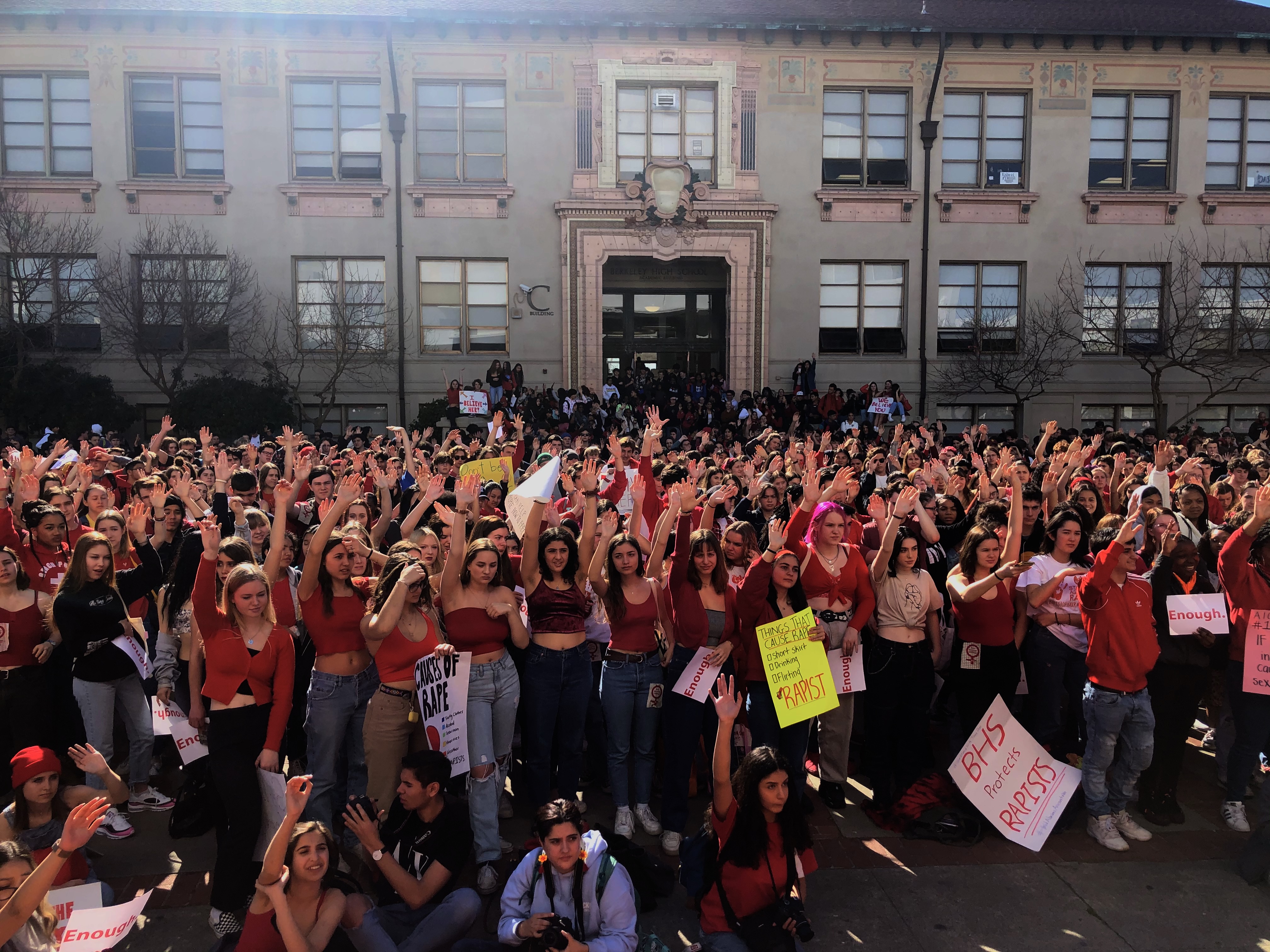When kindergarteners enter the Berkeley school system next year, they will begin a comprehensive consent education program that will continue through high school. Their district will have a formalized Sexual Harassment Advisory Committee and an annual day of district-wide consent programming.
That’s because a group of student-activists at Berkeley High School took on what they described as a persistent “rape culture” at their school and demanded change.
Thousands of students walked out of Berkeley High (BHS) on February 10 and 11. Students shared their traumatic personal experiences of assault at a school-wide open-mic. Activists blocked University Avenue and stormed the school district office and presented at school board and PTA meetings. They drafted a comprehensive list of demands for change, urging the Berkeley Unified School District to do better in their handling of sexual harm incidents.
The call to action came on February 4, when graffiti on a bathroom stall named six male BHS students, listed under the heading “boys to watch out 4.” Next to each student’s name were labels such as “rapist” and “abuser.”
“The list was a desperate cry for help,” said Sylvie Olson-Dorf, a BHS junior. “The female students took it in their own hands to call attention to the fact that these students are dangerous so that the rest of the student body could be aware if the administration isn’t going to remove them from classrooms.”
The emotional impact of the list on the student body was immense. The next day, students plastered the campus with flyers citing statistics about sexual harm. BHS senior and student organizer Ayisha Friedman said that on the day the list went up, during “every single passing period, every single girl I saw was either crying or holding their friend who was crying.”
Junior Etta Washburn said that the students named on the list were social young men who were very visible in the school community. Many play on varsity sports teams, their photos omnipresent on athletic posters around campus.
Washburn “didn’t want to have to go to school and see people who were abusers, or [people who] knew that their friends were abusers, and didn’t say anything,” she said. “I sat across from my friend’s rapist for three months in my ceramics class and I didn’t even know it.”
The week before the graffiti appeared, an anonymous student filed a lawsuit against Berkeley High. The student alleged that a rape had occurred last school year in an unlocked classroom on campus.
Berkeley High has the jurisdiction to discipline, suspend or expel a student when incidents of rape and assault occur on-campus or against a student going to or from school. All BHS staff members are mandated reporters by law. When such a crime is reported to a staff member, they are required to contact the police and other authorities.
The complainant reported the incident to a school counselor, a mandated reporter, who did not report the incident to authorities for ten days. During this time, the complainant still had classes with her alleged assaulter. The alleged assaulter has yet to be reprimanded by the school, even though administrators have the power to do so.
This lawsuit has become known as the “Jane Doe” case, emblematic of Berkeley High’s responses and protocol regarding all sexual harm cases.
When assaults happen on the weekends, outside of school hours, at a party, or at a student’s house, the school lacks the jurisdiction to enact disciplinary consequences such as suspension or expulsion. The school can implement a “safety plan” for victims of assault and rearrange a student’s courses and passing periods to minimize contact with their assaulter.
Olson-Dorf noted that a lot of the work required to make survivors of sexual harm feel safe, such as rearranging a schedule, often falls on the survivor themselves.
Because the Jane Doe case involves an on-campus incident and is receiving much press, students are using it as an opportunity to talk about all the ways they feel the school has failed survivors.
Though it was the lawsuit and the list that brought students to take action, students said that such incidents, and Berkeley High’s persistent rape culture, are nothing new. In 2014 a group of male students made “slut page” Instagram accounts on which students would demean female students and boast of their sexual acts. BHS Stop Harassing, a still-active student group, was founded in response to these pages.
Malcolm Card Gormley, a Berkely High senior, spoke of overhearing conversations in the boys’ bathroom that are emblematic of rape culture. Gormley recalls seeing the fliers that had been posted in the boys’ bathroom the day after the list went up shredded, stepped on, and thrown in the garbage. Gormley said that a lot of male students “get defensive or get personally attacked when we talk about holding men accountable for treating women horribly.”
Friedman said that it was the administration’s disregard for students’ distress, and their expectation to continue “business as usual” in the days after the list and lawsuit, that led her to organize a walkout.
In planning the protest, Friedman reflected on what she saw as the ineffectiveness of previous Berkeley High demonstrations. “We stand in the courtyard for three hours, we all yell, we’re all mad, we’re all angry. And then we leave school,” she said. Given more time to organize, share, and reflect, “‘we can have a discussion about why we’re pissed off… we can get to healing… we can figure out how to solve why we’re pissed off.”
On the first day of student actions, an estimated 2,000 students, clad in red clothing, walked out of class and crowded the school courtyard, holding signs with proclamations such as “Enough” and “BHS Protects Rapists.” Students marched to the nearby Civic Center Park, where organizers held an open-mic.

Friedman said the speeches lasted for five straight hours. Students, many of whom were not originally planning on speaking, gave testimony to their own experiences with rape and assault, dating back as early as elementary school. Many cried. Hundreds of students and teachers stayed and listened. Students walked from the microphone into the arms of their classmates. Students who didn’t even know each other would embrace and cry together.

According to Olson-Dorf, some speakers said, “‘Right now I am saying this to this crowd and I can see my perpetrator in the audience standing with you all, clapping and acting like he stands with us.’”
Many students who spoke out that day said that until they heard the testimony of their classmates, they didn’t even know that their own experiences could be classified as rape or assault.
The first day galvanized the next. Students congregated during the first period and then marched to the Berkeley Unified School District office, shutting down the busy University Avenue thruway in the process. As many students as could fit crowded into a room with Superintendent Brent Stephens, who agreed to listen to the student’s demands.
As recorded on NPR, Stephens said to student protestors: “Our ears are open, and we are committed to working with you to make positive change come out of this moment. So I take seriously that I am accountable to all of you, that I have a job to do on your behalf, and this is the start of those interactions.”
After leaving the district office, students returned to Civic Center Park where they ate donated pizza from a nearby restaurant and participated in various facilitated discussions to process the day, such as a healing circle for survivors of assault and a space for male-identified students to discuss upstandership.
A group of 15 women drafted the demands that were delivered to Stephens that day. A revised version was presented the next week to a BUSD school board meeting. At the board meeting, before each statement was read, a BHS student would give testimony to her own story of assault to demonstrate why the demand was necessary.
While the students of Berkeley high are advocating for themselves with maturity, Washburn doesn’t want anyone to forget that she and her fellow students are children. Students had to act like adults to be treated the way they should be, as young people who need support and protection, she said.
Senior Abigail Sanchez said that the group of women drafted the seven demands in collaboration with the BHS Stop Harassing group, Berkeley High’s Women Student Union, Black Student Union, Latinx Student Union and varsity sports teams. She emphasized the importance of cultural awareness when talking about sex and consent, citing how some communities may be more hesitant to talk about harassment due to stigma and shame.
Sanchez wanted to make sure all students were cared for through the demands, and that the student activism was not solely dictated by the “progressive white culture of Berkeley.”
According to Sanchez, every demand on the list either deals with prevention and education, consequences for perpetrators, or creating a healing space for survivors.
Preventative demands include yearly consent and reporting training for staff, a poster in every classroom about how to report sexual harm, counselor-led upstandership training sessions, and biannual lessons in high and middle schools from a hired consent expert.
Students also demanded that completion of the “Coaching Boys into Men” educational course be required in order to coach or participate in a male sports team and that a student accused and proven to be guilty of perpetrating sexual harm be removed from their team. Students proposed the implementation of an extensive consent curriculum, separate from sex-ed, that begins in Pre-K.
In regards to handling incidents of sexual harm once they occur, students called for an official Berkeley High School Title IX coordinator in addition to a district-wide officer, the presence of two restorative justice officers during all school hours, and a sexual misconduct crisis center staffed with mandated and non-mandated reporters. Students demanded that within one school day of a sexual harm allegation, the class schedule of the reported perpetrator is changed to minimize contact with the survivor and that the survivor receives a week of excused absences and a temporary 504 plan in order to stay on top of coursework.
Though a student accused of an off-campus assault cannot be expelled, students demanded that an accused perpetrator be suspended from school-sanctioned events.
February 10th, the anniversary of the walkouts, will be an annual district-wide day dedicated to consent education, in elementary, middle, and high schools. Students also hope to institutionalize the district-wide Sexual Harassment Advisory Committee, which will, according to the demands, “report the status of climate, programs, data collection and progress around issues of misconduct.”
Adults are listening. Stephens met with Friedman on February 27, just over a week after the school board meeting, to discuss a budget he had already calculated to implement students’ demands.
As a result of BHS student activism, Washburn hopes “that the administration is able to better protect its students after us. I hope that they can do more and they have more power and that people are happy and healthy and able to go to school.”
Sanchez noted that while the issue of sexual harm has been gaining more attention regarding “celebrities and the casting couch and the office place,” there has yet to be a nation-wide movement regarding sexual harm in schools. Sanchez believes that high school is one of the most important places to talk about assault.
“I think our community understands that now,” she said.
Friedman is proud that her activism has reached a wide audience. “It’s not like Berkeley High is unique to this issue,” she said. “This happens all over the world. The more people that are looking at us the more people are going to be inspired to stand up as well.”







